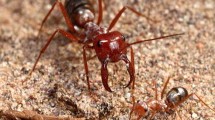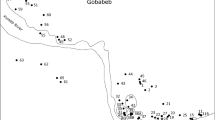Abstract
Coptotermes lacteus, a termite found in eastern Australia, is a central-site nester that constructs mounds up to 2 m in height. Mature colonies typically contain the primary king and queen, and up to a million or more worker and soldier offspring. Once a year, male and female nymphs are produced in approximately equal numbers and develop into new alates. Experimental removal of the queen in the field and subsequent mating of the king with a replacement queen, results in an unusual phenomenon whereby the production of female nymphs completely ceases, while the production of male nymphs, and workers of both sexes, continues. The proximate cause of this nymph male-bias is yet to be discovered. The production of male nymphs and workers of both sexes in de-queened C. lacteus colonies is equivalent to offspring production patterns in laboratory crosses of male nymphoid (nymph-derived) with female ergatoid (worker-derived) replacement reproductives in the related species Reticulitermes speratus. An X-linked genetically influenced caste determination (GCD) mechanism has been proposed to account for such offspring patterns in R. speratus. We examined microsatellite genotypes in C. lacteus to test a prediction arising from the R. speratus GCD model: that nymphs should result from reproduction by neotenics, rather than the primary pair. In five of six colonies examined, genotypes indicated that all workers and nymphs were derived from a single reproductive pair. In three of these cases, the primary queen was also located and examined; her genotype matched that inferred from worker and nymph genotypes. These results suggest that the GCD model proposed for R. speratus does not apply to C. lacteus, at least under field conditions. The male-nymph bias following queen removal therefore remains an unresolved issue in C. lacteus.

Similar content being viewed by others
References
Anderson K.E., Linksvayer T.A. and Smith C.R. 2008. The causes and consequences of genetic caste determination in ants (Hymenoptera: Formicidae). Myrmecol. News 11: 119–132
Charlesworth B. 1980. Models of kin selection. In: Evolution of Social Behavior: Hypotheses and Empirical Tests (Markl H., Ed), Verlag Chemie GMBH, Weinheim, pp 11–26
Fournier D., Estoup A., Orivel J., Foucaud J., Jourdan H., Breton J.L. and Keller L. 2005. Clonal reproduction by males and females in the little fire ant. Nature 435: 1230–1234
Hayashi Y., Lo N., Miyata H. and Kitade O. 2007. Sex-linked genetic influence on caste determination in a termite. Science 318: 985–987
Helms Cahan S. and Keller L. 2003. Complex hybrid origin of genetic caste determination in harvester ants. Nature 424: 306–309
Husseneder C. and Simms D.M. 2008. Size and heterozygosity influence partner selection in the Formosan subterranean termite. Behav. Ecol. 19: 764–773
Husseneder C., Simms D.M. and Ring D.R. 2006. Genetic diversity and genotypic differentiation between the sexes in swarm aggregations decrease inbreeding in the Formosan subterranean termite. Insect. Soc. 53: 212–219
Julian G.E., Fewell J.H., Gadau J., Johnson R.A. and Larrabee D. 2002. Genetic determination of the queen caste in an ant hybrid zone. Proc. Natl Acad. Sci. U S A 99: 8157–8160
Lenz M. and Runko S. 1993. Long-term impact of orphaning of field colonies of Coptotermes lacteus (Froggatt) (Isoptera: Rhinotermitidae). Insect. Soc. 40: 439–456
Lo N., Hayashi Y. and Kitade O. 2009. Should environmental caste determination be assumed for termites? Am. Nat. 173: 848–853
Miura T. and Matsumoto T. 1996. Ergatoid reproductives in Nasutitermes takasagoensis (Isoptera: Termitidae). Sociobiology 27: 223–238
Queller D.C. and Strassmann J.E. 1998. Kin selection and social insects. BioScience 48: 165–175
Roisin Y. and Lenz M. 1999. Caste developmental pathways in colonies of Coptotermes lacteus (Froggatt) headed by primary reproductives (Isoptera, Rhinotermitidae). Insect. Soc. 46: 273–280
Roisin Y. and Lenz M. 2002. Origin of male-biased sex allocation in orphaned colonies of the termite, Coptotermes lacteus. Behav. Ecol. Sociobiol. 51: 472–479
Schwander T., Lo N., Beekman M., Oldroyd B.P. and Keller L. 2010. Nature vs nurture in social insect caste determination. Trends Ecol. Evol. 25: 275–282
Thompson G.J., Lenz M. and Crozier R.H. 2000. Microsatellites in the subterranean, mound-building termite Coptotermes lacteus (Isoptera: Rhinotermitidae). Mol. Ecol. 9: 1932–1934
Thompson G.J., Lenz M., Crozier R.H. and Crespi B.J. 2007. Molecular-genetic analyses of dispersal and breeding behaviour in the Australian termite Coptotermes lacteus: evidence for non-random mating in a swarm-dispersal mating system. Aust. J. Zool. 55: 219–227
Vargo E.L., Husseneder C. and Grace J.K. 2003. Colony and population genetic structure of the Formosan subterranean termite, Coptotermes formosanus, in Japan. Mol. Ecol. 12: 2599–2608
Volny V.P. and Gordon D.M. 2002. Genetic basis for queen-worker dimorphism in a social insect. Proc. Natl Acad. Sci. U S A 99: 6108–6111
Wheeler D.E. 1986. Developmental and physiological determinants of caste in social Hymenoptera – evolutionary implications. Am. Nat. 128: 13–34
Acknowledgments
We thank Patrick Gleeson and Aaron Bartlett for mound dissection and queen discovery, and two anonymous reviewers for useful comments on an early version of this manuscript. This study was supported by the Australian Research Council.
Author information
Authors and Affiliations
Corresponding author
Rights and permissions
About this article
Cite this article
Ujvari, B., Li, B., Evans, T.A. et al. A microsatellite-based test of the Reticulitermes speratus genetic caste determination model in Coptotermes lacteus . Insect. Soc. 58, 365–370 (2011). https://doi.org/10.1007/s00040-011-0153-2
Received:
Revised:
Accepted:
Published:
Issue Date:
DOI: https://doi.org/10.1007/s00040-011-0153-2




